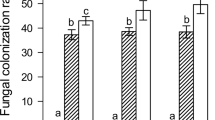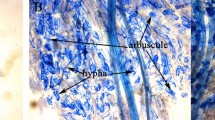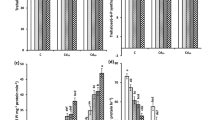Abstract
Arbuscular mycorrhizal fungi (AMF) are known to alleviate the undesirable effects of biotic and abiotic stresses on plants. The objective of this study was to assess the effect of AMF symbiosis on plant growth, physiology, and nutrients accumulation in leaves and roots of Ailanthus altissima (Mill.) Swingle under Cd and saline conditions. The pot experiment was carried out in factorial based on randomized complete block design (RCBD) with three replications. The treatments included salinity at three levels (non-saline water, 4 ds/m, and 8 ds/m), inoculation with AMF at two levels (uninoculation and Glomus mosseae inoculation) and cadmium (Cd) pollution at three levels (unpolluted soil, 15 mg Cd/kg soil, and 30 mg Cd/kg soil). The results revealed salinity and Cd pollution decreased plant height shoot and root biomass, but AMF increased them. The highest plant height, shoot and root biomass were observed at unpolluted and non-saline water. In contrast, the lowest plant growth was in uninoculated treatments with high salinity and Cd levels. Salinity increased proline content, CAT and SOD activities. Cd pollution did not change the proline concentration in the plants. The highest proline concentration and antioxidant enzyme (SOD and CAT) activities were observed in uninoculated plants with simultaneous application of high Cd and salt levels. Na+ accumulation in roots and leaves increased with salinity, but AMF decreased it. K+ content in leaves and roots decreased with Cd pollution and salinity and AMF increased it. Salinity and Cd pollution significantly accumulated high Cd in roots and leaves. Our work will widely improve the current knowledge of salinity and Cd tolerance mechanisms in tree species.




Similar content being viewed by others
REFERENCES
Machado, R.M.A., and Serralheiro, R.P., Soil salinity: effect on vegetable crop growth. Management practices to prevent and mitigate soil salinization, Horticulturae, 2017, vol. 3, p. 30.
Venâncio, C., Pereira, R., and Lopes, I., The influence of salinization on seed germination and plant growth under mono and polyculture, Environ. Pollut., 2002. vol. 35, p. 113993.
Chakraborty, U., Chakraborty, B.N., Dey, P.L., Chakraborty, A.P., and Sarkar, J., Biochemical responses of wheat plants primed with Ochrobactrum pseudogrignonense and subjected to salinity stress, Agric. Res., 2019, vol. 8, p. 427.
Xu, Z.M., Li, Q.S., Yang, P., Ye, H.J., Chen, Z.S., Guo, S.H., and Zeng, E.Y., Impact of osmoregulation on the differences in Cd accumulation between two contrasting edible amaranth cultivars grown on Cd-polluted saline soils, Environ. Pollut., 2017, vol. 224, p. 89.
Hou, D., O’Connor, D., Nathanail, P., Tian, L., and Ma, Y., Integrated GIS and multivariate statistical analysis for regional scale assessment of heavy metal soil contamination: a critical review, Environ. Pollut., 2017, vol. 231, p. 1188.
Nabulo, G., Black, C.R., and Young, S.D., Trace metal uptake by tropical vegetables grown on soil amended with urban sewage sludge, Environ. Pollut., 2011, vol. 159, p. 368.
Duan, G., Zhang, H., Liu, Y., Jia, Y., Hu, Y., and Cheng, W., Long-term fertilization with pig-biogas residues results in heavy metal accumulation in paddy field and rice grains in Jiaxing of China, Soil Sci. Plant Nutr., 2012, vol. 58, p. 637.
Wang, Y., Jiang, X., Li, K., Wu, M., Zhang, R., Zhang, L., and Chen, G., Photosynthetic responses of Oryza sativa L. seedlings to cadmium stress: physiological, biochemical and ultrastructural analyses, Biometals, 2014, vol. 27, p. 389.
Latef, A.A.H.A., Hashem, A., Rasool, S., Abd_Allah, E.F., Alqarawi, A.A., Egamberdieva, D., and Ahmad, P., Arbuscular mycorrhizal symbiosis and abiotic stress in plants: a review, J. Plant Biol., 2016, vol. 59, p. 407.
Juniper, S. and Abbott, L.K., Soil salinity delays germination and limits growth of hyphae from propagules of arbuscular mycorrhizal fungi, Mycorrhiza, 2006, vol. 16, p. 371.
Djighaly, P.I., Diagne, N., Ngom, M., Ngom, D., Hocher, V., Fall, D., and Champion, A., Selection of arbuscular mycorrhizal fungal strains to improve Casuarina equisetifolia L., and Casuarina glauca Sieb. tolerance to salinity, Ann. For. Sci., 2018, vol. 75, p. 72.
Balliu, A., Sallaku, G., and Rewald, B., AMF inoculation enhances growth and improves the nutrient uptake rates of transplanted, salt-stressed tomato seedlings, Sustainablity, 2015, vol. 7, p. 15967.
Hashem, A., Abd-Allah, E.F., Alqarawi, A.A., Aldubise, A., and Egamberdieva, D., Arbuscularmycorrhizal fungi enhances salinity tolerance of Panicum turgidum Forssk. by altering photosynthetic and antioxidant pathways, J. Plant Interact., 2015, vol. 10, p. 320.
Upreti, K.K., Bhatt, R.M., Panneerselvam, P., and Varalakshmi, L.R., Morphophysiological responses of grape rootstock ‘Dogridge’to arbuscularmycorrhizal fungi inoculation under salinity stress, Int. J. Fruit Sci., 2016, vol. 16, p. 191.
Knüsel, S., Liu, J., Conedera, M., Gärtner, H., Bugmann, H., Li, M.H., and Wunder, J., Comparative dendroecological characterisation of Ailanthus altissima (Mill.) Swingle in its native and introduced range, Dendrochronologia, 2019, vol. 57, p. 125608.
Abbaslou, H. and Bakhtiari, S., Phytoremediation potential of heavy metals by two native pasture plants (Eucalyptus grandis and Ailanthus altissima) assisted with AMF and fibrous minerals in contaminated mining regions, Pollution, 2017, vol. 3, p. 471.
Kowarik, I. and Säumel, I., Biological flora of central Europe: Ailanthus altissima (Mill.) Swingle, Perspect. Plant Ecol., Evol. Syst., 2007, vol. 8, p. 207
Gerdemann, J.W. and Nicolson, T.H., Spores of mycorrhizal Endogone species extracted from soil by wet sieving and decanting. Trans. Br. Mycol. Soc., 1963, vol. 46, p. 235.
Sousa, N.R., Ramos, M.A., Marques, A.P., and Castro, P.M., The effect of ectomycorrhizal fungi forming symbiosis with Pinus pinaster seedlings exposed to cadmium, Sci. Total Environ., 2012, vol. 414, p. 63.
Khoyerdi, F.F., Shamshiri, M.H., and Estaji, A., Changes in some physiological and osmotic parameters of several pistachio genotypes under drought stress, Sci. Hortic. (Amsterdam), 2016, vol. 198, p. 44.
Bates, L.S., Waldren, R.P., and Teare, I.D., Rapid determination of free proline for water-stress studies, Plant Soil, 1973, vol. 39, p. 205.
Beauchamp, C. and Fridovich, I., Superoxide dismutase: improved assays and an assay applicable to acrylamide gels, Anal. Biochem., 1971, vol. 44, p. 276.
Chandlee, J.M. and Scandalios, J.G., Analysis of variants affecting the catalase developmental program in maize scutellum, Theor. Appl. Genet., 1984, vol. 69, p. 71.
Rahneshan, Z., Nasibi, F., and Moghadam, A.A., Effects of salinity stress on some growth, physiological, biochemical parameters and nutrients in two pistachio (Pistacia vera L.) rootstocks, J. Plant Interact., 2018, vol. 13, p. 73.
Munns, R. and Tester, M., Mechanisms of salinity tolerance. Annu. Rev. Plant Biol., 2008, vol. 59, p. 651.
Rahneshan, Z., Nasibi, F., and Moghadam, A.A., Effects of salinity stress on some growth, physiological, biochemical parameters and nutrients in two pistachio (Pistaci avera L.) rootstocks, J. Plant Interact., 2018, vol. 13, p. 73.
Karimi, H.R. and Sadeghi-Seresht, E., Effects of salinity stress on growth indices, physiological parameters and element concentration in Banebaghi (Pistacia sp.) as rootstock for pistachio, J. Plant Nutr., 2018, vol. 41, p. 1094.
Ahmad, P., Sarwat, M., Bhat, N.A., Wani, M.R., Kazi, A.G., and Tran, L.S.P., Alleviation of cadmium toxicity in Brassica juncea L. (Czern. & Coss.) by calcium application involves various physiological and biochemical strategies, PloS One, 2015, vol. 10, p. 230.
Talaat, N.B., and Shawky, B.T., Protective effects of arbuscular mycorrhizal fungi on wheat (Triticum aestivum L.) plants exposed to salinity, Environ. Exp. Bot., 2014, vol. 98, p. 20.
Shamshiri, M.H. and Fattahi, M., Evaluation of two biochemical markers for salt stress in three pistachio rootstocks inoculated with arbuscular mycorrhiza (Glomus mosseae), J. Stress Physiol. Biochem., 2014, vol. 10, p. 280.
ACKNOWLEDGMENTS
The authors are grateful to the University of Tehran for the greenhouse for doing the experiment.
Funding
This work was not supported by the specific funding. It was financially done by all authors’ contributions.
Author information
Authors and Affiliations
Contributions
All authors contributed equally to this work.
Corresponding author
Ethics declarations
Conflict of interests. The authors declare that they have no conflicts of interest.
Statement on the welfare of humans or animals. This article does not contain any studies involving animals performed by any of the authors.
Supplementary Information
Rights and permissions
About this article
Cite this article
Alsadat Hashemi Nejad, R., Kafi, M., Jari, S.K. et al. Arbuscular Mycorrhizal Fungi Improve Growth, Physiological Status and Nutrients Accumulation of Ailanthus altissima Seedlings under Cadmium Pollution and Salinity. Russ J Plant Physiol 68, 266–273 (2021). https://doi.org/10.1134/S102144372102014X
Received:
Revised:
Accepted:
Published:
Issue Date:
DOI: https://doi.org/10.1134/S102144372102014X




